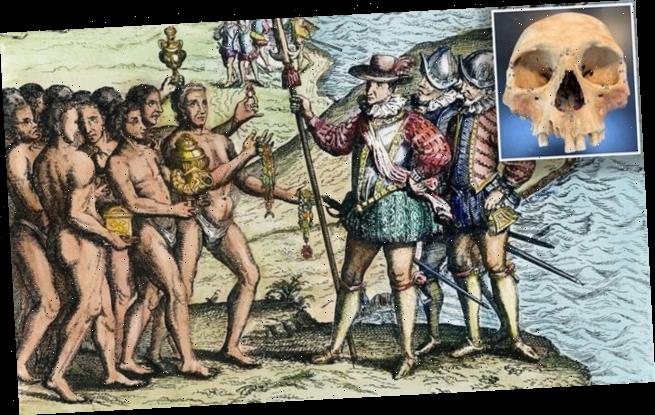Columbus’ CANNIBAL claims may have been true after all: Study shows South American ‘Caribs’ invaded the Caribbean in 800AD
- The study discovered that the Caribs settled in the Caribbean by about 800AD
- Columbus claimed ‘Carib’ raiders would abduct women and cannibalize men
- This has long been disputed as it was thought they had never got that far north
- ‘Facial recognition’ technology helped the team to discover Columbus was right
Marauding ‘Caribs’ invaded the Caribbean in 800AD – earlier than previously thought – adding credibility to cannibalism claims by Christopher Columbus.
The Spanish explorer’s claims were long thought to be a myth but the latest research from the Florida Museum of Natural History suggest he may have been right.
The team used a technology similar to facial recognition to analyse the skulls of early Caribbean inhabitants to find the relationships between groups of people.
They found that the ‘Caribs’, marauders from South America and rumored cannibals, had already settled in the Bahamas 700 years before Columbus arrived in 1492.
Columbus claimed the peaceful Arawaks, who also lived there, were terrorized by Carib raiders who he said ‘practiced abduction of women and cannibalism of men’.
‘I’ve spent years trying to prove Columbus wrong when he was right’, admitted William Keegan, senior researcher at the museum.
Scroll down for video
Researchers say that by adding a biological component they were able to bring the regions history into a sharper focus. They studied the skulls of early Carribean settlers like this one
‘We’re going to have to reinterpret everything we thought we knew’, he said.
Researchers tested skulls using modern techniques and were able to reveal that there was actually a Carib presence in the Caribbean when Columbus visited – and in fact much earlier and much more prominent than they expected.
Previous studies relied on artifacts such as tools and pottery to trace the geographical origin and movement of people through the Caribbean over time.
Researchers say that by adding a biological component they were able to bring the regions history into a sharper focus.
Arawaks and Caribs were enemies, but they often lived side by side with occasional intermarriage before blood feuds erupted, according to researchers
Ann Ross, a professor of biological sciences at North Carolina State University used 3D facial ‘landmarks,’ such as the size of an eye socket or length of a nose, to analyze more than 100 skulls dating from about 800AD to 1542.
‘These landmarks can act as a genetic proxy for determining how closely people are related to one another’, she said.
‘The analysis not only revealed three distinct Caribbean people groups, but also their migration routes, which was really stunning.’
Looking at ancient faces shows the Caribbean’s earliest settlers came from the Yucatan, moving into Cuba and the Northern Antilles.
‘This supports a previous hypothesis based on similarities in stone tools.’
‘The earliest inhabitants of the Bahamas and Hispaniola, however, were not from Cuba as commonly thought, but the Northwest Amazon – the Caribs’, Dr Ross said.
Around 800AD, the Caribs pushed north into Hispaniola and Jamaica and then the Bahamas – where they were well established by the time Columbus arrived.
‘I had been stumped for years as I didn’t have the Bahama component,’ she said.
‘Those remains were so key. This will change the perspective on the people and peopling of the Caribbean.’
For Dr Keegan, the discovery lays to rest a puzzle that pestered him for years – why a type of pottery known as Meillacoid appears in Hispaniola by 800AD, Jamaica around 900AD and the Bahamas around 1000AD.
‘Why was this pottery so different from everything else we see?’ he said. ‘It makes sense that Meillacoid pottery is associated with the Carib expansion.’
They found that the ‘Caribs’ had already settled Jamaica and the Bahamas 700 years before Columbus arrived in 1492
The sudden appearance of Meillacoid pottery also corresponds with a general reshuffling of people in the Caribbean after a 1,000-year period of tranquility, further evidence that ‘Carib invaders were on the move,’ Dr Keegan said.
Arawaks and Caribs were enemies, but they often lived side by side with occasional intermarriage before blood feuds erupted, he said.
“Maybe there was some cannibalism involved. If you need to frighten your enemies, that’s a really good way to do it.
‘Whether or not it was accurate, the European perception that Caribs were cannibals had a tremendous impact on the region’s history.
‘The Spanish monarchy initially insisted that indigenous people be paid for work and treated with respect, but reversed its position after receiving reports that they refused to convert to Christianity and ate human flesh.’
This led the Spanish crown to say ‘if they’re going to behave that way they can all be enslaved’, according to Dr Keegan.
The findings have been published in the journal Scientific Reports.
WHAT ARE THE HEALTH IMPLICATIONS OF EATING HUMAN MEAT?
Humans could have practised cannibalism for as long as 100,000 years.
Human flesh is less calorific than the meat of large prehistoric animals including woolly rhinos, red deer and mammoths, researchers found.
Scientists have previously suggested that early humans turned cannibal to get a much-needed protein boost when food was scarce.
But now they believe our early ancestors may have actually feasted on human flesh as part of a cultural or social ritual.
Anecdoral accounts suggest we taste between pork and veal.
However, eating human meat comes with a range of potential health complications, including contracting blood borne diseases such as Hepatitis or Ebola, writes Medical Daily.
Our flesh contains prions, which are versions of normal proteins that that lost their function and become infectious.
These can transform healthy proteins and cause a chain reaction of disease.
Specifically, if these proteins get in the brain they ultimately cause death.
Unlike bacteria and fungi, these prions are not eradicated by heat.
‘They could be present in any nervous tissue, including our organs and muscles. However, they are most common in the brain and spinal nerve tissues’, researchers wrote in the publication.
‘Eating human flesh isn’t always bad for us, especially if it lacks prions, but doing so carries an exceptionally high risk that’s not worth sinking your teeth into.’
Source: Read Full Article



